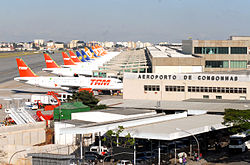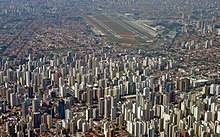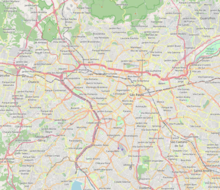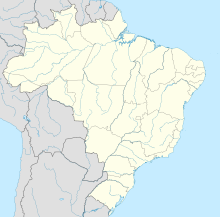São Paulo–Congonhas Airport
São Paulo/Congonhas–Deputado Freitas Nobre Airport Aeroporto de São Paulo/Congonhas–Deputado Freitas Nobre | |||||||||||||||
|---|---|---|---|---|---|---|---|---|---|---|---|---|---|---|---|
 | |||||||||||||||
| Summary | |||||||||||||||
| Airport type | Public | ||||||||||||||
| Operator | |||||||||||||||
| Serves | São Paulo | ||||||||||||||
| Opened | 12 April 1936 | ||||||||||||||
| Hub for |
| ||||||||||||||
AMSL | 803 m / 2,634 ft | ||||||||||||||
| Coordinates | 23°37′34″S 046°39′23″W / 23.62611°S 46.65639°W | ||||||||||||||
| Map | |||||||||||||||
| Runways | |||||||||||||||
| |||||||||||||||
| Statistics (2023) | |||||||||||||||
| |||||||||||||||
São Paulo/Congonhas–Deputado Freitas Nobre Airport (IATA: CGH, ICAO: SBSP) Portuguese pronunciation: [kõˈɡõɲɐs] is one of the four commercial airports serving São Paulo, Brazil. The airport is named after the neighborhood where it is located, called Vila Congonhas, property of the descendants of Lucas Antônio Monteiro de Barros (1767–1851), Viscount of Congonhas do Campo, first president of the province of São Paulo after the independence of Brazil in 1822, during the Empire. In turn, the Viscount's domain was named after the plural of a shrub known in Brazil as congonha-do-campo (Luxemburgia polyandra, of the Ochnaceae family).[4] Since June 19, 2017, it is officially named after Deputy José Freitas Nobre.[5] The name Congonhas, however, remains mostly used. It is owned by the City of São Paulo.
The airport is operated by AENA.
Congonhas has
The central hall of the passenger terminal is considered one of the most outstanding examples of modern architecture in São Paulo. However, modernizing and enlargement work has been conducted at the terminal from 2003 onwards, while trying to preserve the look of the older, historic section. Today the main terminal has 51,535 m2 (554,718 sq.ft) of space.[4]
History





The airport was initially planned in 1919, but it did not open until 12 April 1936. During the 1950s, Congonhas served all international flights to/from São Paulo, as its runways could accommodate the Lockheed Constellations,
On 21 May 1959, a formal agreement between Varig, Cruzeiro do Sul and VASP created the shuttle service to Rio de Janeiro that made the airport famous, being the first of its kind in the world. The service was called Air Bridge (Portuguese: Ponte Aérea), inspired on the Berlin Airlift; its first flight was operated on 6 July 1959. It operated between Rio de Janeiro–Santos Dumont and Congonhas Airports and comprised regular departures, usually every half-hour, a common check-in counter and simplified tickets and formalities.[8] The service was an instant success. Sadia, later known as Transbrasil, joined the partnership in 1968. In 1999 the service was discontinued, as more competitive economic times made airlines decide to operate their services independently on that route.[9]
Until 1985, Congonhas was the main airport of
Since the opening of
The airport administrator, Infraero, started in 2003 a comprehensive renovation plan of the airport complex. A remodeling of departure and arrival halls with installation of 12 jetways was completed on 15 August 2004. In December 2005, a new parking garage was opened. The runways were resurfaced between February and September 2007. Runway length has not been extended because of the rapid growth of São Paulo, which has completely surrounded the airport.
The airport has been troubled by slippery runways and has had several accidents where water accumulation has been a significant factor, the most notable being the one involving
The largest aircraft now operating at Congonhas are the Airbus A320 and the Boeing 737-800. However, in the past the airport used to have operations with Douglas DC-8 Vasp Cargo, Airbus A300 wide-body aircraft, by the now-defunct airlines Cruzeiro do Sul, Varig, VASP and Boeing 767-200[10] of also former Trans-Brasil.
In 2008 Congonhas lost its designation as an international airport.
On 31 August 2009, Infraero unveiled a R$164.7 million (US$86.8 million; EUR 60.8 million) investment plan to up-grade Congonhas Airport focusing on the preparations for the 2014 FIFA World Cup, which were held in Brazil, São Paulo being one of the venue cities. The investment involved a new control tower,[11] renovation of the apron, conclusion of the renovation on the south portion of the passenger terminal, and renovation of the north portion of the passenger terminal.[12]
Previously operated by Infraero, on August 18, 2022, the consortium AENA won a 30-year concession to operate the airport.[13]
Airlines and destinations
| Airlines | Destinations |
|---|---|
| Azul Conecta | Rio de Janeiro–Jacarepaguá Seasonal: Blumenau |
Note:
Statistics


Following is the number of passenger, aircraft and cargo movements at the airport, according to Infraero (2007-2022) and AENA (2023) reports:[14][15][1]
| Year | Passenger | Aircraft | Cargo (t) |
|---|---|---|---|
| 2023 | 22,032,407 |
231,861 |
32,491 |
| 2022 | 18,075,764 |
196,137 |
31,754 |
| 2021 | 9,677,569 |
126,277 |
16,892 |
| 2020 | 6,991,460 |
97,450 |
15,123 |
| 2019 | 22,681,392 |
217,254 |
57,417 |
| 2018 | 22,125,712 |
222,298 |
51,521 |
| 2017 | 21,859,453 |
217,918 |
50,253 |
| 2016 | 20,816,957 |
213,043 |
49,231 |
| 2015 | 19,279,644 |
213,833 |
54,507 |
| 2014 | 18,134,768 |
205,407 |
59,588 |
| 2013 | 17,119,530 |
209,555 |
62,460 |
| 2012 | 16,775,770 |
213,419 |
60,345 |
| 2011 | 16,756,452 |
209,280 |
34,778 |
| 2010 | 15,499,462 |
204,943 |
23,383 |
| 2009 | 13,699,657 |
193,308 |
29,247 |
| 2008 | 13,672,301 |
186,694 |
32,519 |
| 2007 | 15,265,433 | 205,564 | 34,905 |
Accidents and incidents
- 18 August 1941: a Panair do Brasil Lockheed Model 18 Lodestar registration PP-PBD en route from Curitiba-Bacacheri to São Paulo–Congonhas crashed on the Cantareira mountain range near São Paulo. 8 out of 13 passengers and crew aboard died.[16][17]
- 28 September 1942: a Panair do Brasil Lockheed Model 18 Lodestar registration PP-PBG en route from Rio de Janeiro–Santos Dumont to São Paulo–Congonhas crashed on the location of Pedra Branca, near Santo André. All 15 passengers and crew died.[16][18]
- 31 August 1944: a Panair do Brasil Lockheed Model 18 Lodestar registration PP-PBI crashed while on night approach to São Paulo–Congonhas under heavy fog. All 16 occupants died.[19][20]
- 13 March 1948: a Cruzeiro do Sul Douglas DC-3 registration PP-CBX flying to São Paulo–Congonhas crashed on Cantareira Range, near São Paulo. All 6 passengers and crew aboard died.[21]
- 8 September 1951: a VASP Douglas C-47 registration PP-SPQ struck a house after take-off from São Paulo–Congonhas and crashed. Thirteen passengers and crew and three persons on the ground died.[22]
- 13 May 1952: a VASP Douglas C-47 registration PP-SPM operating a flight from São Paulo–Congonhas to Bauru lost control when carrying out an emergency landing following an engine failure. Two crew members and 3 passengers died.[23]
- 17 June 1953: a Panair do Brasil Lockheed L-049 Constellation registration PP-PDA operating flight 263 crashed on final approach to São Paulo–Congonhas. Apparently causes are related to night operations with little visibility. All 17 passengers and crew died.[24][25]
- 4 June 1954: a
- 23 September 1959: a VASP Saab 90 Scandia registration PP-SQV en route from São Paulo–Congonhas to Rio de Janeiro–Santos Dumont during climb after take-off did not gain enough height and crashed 1+1⁄2 minutes out of São Paulo, killing all 20 passengers and crew.[28][29]
- 15 January 1963: a
- 3 May 1963: a Convair 340 registration PP-CDW flying from São Paulo–Congonhas to Rio de Janeiro–Santos Dumont had to return to São Paulo after no. 2 engine caught fire. When on finals to touch down, the aircraft nosed up 45°, stalled and struck a house. Of the 50 passengers and crew aboard, 37 died.[32][33]
- 30 May 1972: a Porto Alegre was hijacked. The hijacker demanded money. The aircraft was stormed and the hijacker was shot.[34]
- 27 February 1975: a VASP Embraer EMB 110 Bandeirante registration PP-SBE operating flight 640 from São Paulo–Congonhas to Bauru crashed after take-off from Congonhas. The 2 crew members and 13 passengers died.[35][36]
- 31 October 1996: a
- 9 July 1997: a TAM Airlines Fokker 100 registration PT-WHK operating flight 283 en route from São José dos Campos to São Paulo–Congonhas was climbing after take-off from São José dos Campos when a bomb exploded in the rear part of the passenger cabin. The uncontrolled decompression blew one passenger out of the aircraft. The aircraft made a successful emergency landing in São Paulo, despite the hole in the fuselage.[39]
- 16 July 2007: Pantanal Linhas Aéreas Flight 4763 to Juiz de Fora, an ATR 42, veered off Runway 17R after landing in light rain. The aircraft struck a light pole, a concrete box, and pavement of an adjacent taxiway, collapsing the nose landing gear. None of the 25 passengers and crew were injured, but the aircraft was written off. The accident was attributed to hydroplaning and the pilot's inappropriate rudder pedal inputs in reaction to this condition.[40]
- 17 July 2007: a Porto Alegre to São Paulo–Congonhas overran the 35L runway while landing at Congonhas, crossed a major thoroughfare and impacted against a TAM Express warehouse. All 187 passengers and crew and 12 on the ground perished. 199 bodies were recovered from the crash site, including passengers, crew and people that were working at the warehouse. It remains the deadliest aviation accident in Brazilian territory. In 2022 the airport installed EMAS Engineered materials arrestor system from RunwaySafe group to avoid future overrun accidents.[41]
Access
The airport is located 8 km (5 mi) from downtown São Paulo, at Washington Luís Avenue, in the district of Campo Belo.
Azul Brazilian Airlines offers free bus transfers for its passengers between Congonhas and Campinas-Viracopos International Airport during regular times.[42]
Further bus transportation is also available through the Airport Bus Service, an executive bus line, administered by
See also
References
- ^ a b "Estatísticas". AENA Brasil (in Portuguese). Retrieved 29 January 2024.
- ^ "Aeródromos". ANAC (in Portuguese). 29 June 2020. Retrieved 9 March 2021.
- ^ "Congonhas - Deputado Freitas Nobre (SBSP)". DECEA (in Portuguese). Retrieved 22 April 2024.
- ^ a b c "Aeroporto de Congonhas: Histórico" (in Portuguese). Infraero. Archived from the original on 5 June 2012. Retrieved 4 August 2011.
- ^ "Lei nº 13.450, de 16 de junho de 2017" (in Portuguese). Palácio do Planalto. 16 June 2017. Archived from the original on 8 August 2019. Retrieved 8 August 2019.
- ^ "Procedimento de alocação de slots disponíveis" (PDF) (in Portuguese). ANAC. Archived (PDF) from the original on 25 January 2012. Retrieved 3 August 2011.
- ^ a b c d Saconi, Rose (2 April 2013). "Como era São Paulo sem o aeroporto de Congonhas" (in Portuguese). O Estado de S. Paulo (acervo). Archived from the original on 20 August 2013. Retrieved 18 July 2013.
- ISBN 978-85-7430-901-9.
- ^ "Ponte Aérea completa meio século". Revista da Associação dos tripulantes da TAM (in Portuguese). 2009. pp. 2–3.
- ^ Transbrasil Boeing 767. Boeing 767, o primeiro do Brasil (video). São Paulo, Brazil: YouTube. Retrieved 23 July 2007.
- ^ "Congonhas: nova torre começa a funcionar" (in Portuguese). O Estado de S. Paulo. 8 May 2013. Archived from the original on 9 May 2013. Retrieved 8 May 2013.
- ^ Rittner, Daniel; Braga, Paulo Victor (31 August 2009). "Infraero vai gastar R$ 5 bi em reforma de aeroportos". Valor Econômico (in Portuguese). pp. A4. Archived from the original on 6 July 2011. Retrieved 18 March 2010.
- ^ "Única empresa a apresentar proposta, Aena leva Aeroporto de Congonhas". Agência Brasil (in Portuguese). 18 August 2022. Retrieved 19 August 2022.
- ^ "Anuário Estatístico Operacional" (PDF). Infraero (in Portuguese). 12 April 2012. Retrieved 5 March 2024.
- ^ "Estatísticas". Infraero (in Portuguese). Retrieved 5 March 2024.
- ^ a b Pereira, Aldo (1987). Breve História da Aviação Comercial Brasileira (in Portuguese). Rio de Janeiro: Europa. p. 338.
- ISBN 978-85-7430-760-2.
- ISBN 978-85-7430-760-2.
- ^ "Accident description PP-PBI". Aviation Safety Network. Archived from the original on 4 November 2012. Retrieved 17 August 2011.
- ISBN 978-85-7430-760-2.
- ^ "Accident description PP-CBX". Aviation Safety Network. Archived from the original on 4 November 2012. Retrieved 17 August 2011.
- ^ "Accident description PP-SPQ". Aviation Safety Network. Archived from the original on 4 November 2012. Retrieved 18 August 2011.
- ^ "Accident description PP-SPM". Aviation Safety Network. Archived from the original on 3 November 2012. Retrieved 20 May 2011.
- ^ "Accident description PP-PDA". Aviation Safety Network. Archived from the original on 19 July 2012. Retrieved 17 August 2011.
- ISBN 978-85-7430-760-2.
- ^ "Accident description PP-VBZ". Aviation Safety Network. Archived from the original on 4 November 2012. Retrieved 16 August 2011.
- ISBN 978-85-7430-760-2.
- ^ "Accident description PP-SQV". Aviation Safety Network. Archived from the original on 4 November 2012. Retrieved 18 August 2011.
- ISBN 978-85-7430-760-2.
- ^ "Accident description PP-CEV". Aviation Safety Network. Archived from the original on 6 August 2011. Retrieved 17 August 2011.
- ISBN 978-85-7430-760-2.
- ^ "Accident description PP-CDW". Aviation Safety Network. Archived from the original on 4 November 2012. Retrieved 17 August 2011.
- ISBN 978-85-7430-760-2.
- ^ "Incident description PP-VJL". Aviation Safety Network. Archived from the original on 4 November 2012. Retrieved 16 August 2011.
- ^ "Accident description PP-SBE". Aviation Safety Network. Archived from the original on 3 November 2012. Retrieved 20 May 2011.
- ISBN 978-85-7430-760-2.
- ^ "Accident description PT-MRK". Aviation Safety Network. Archived from the original on 23 January 2009. Retrieved 17 August 2011.
- ISBN 978-85-7430-760-2.
- ^ "Accident description PT-WHK". Aviation Safety Network. Archived from the original on 9 December 2011. Retrieved 13 August 2011.
- ^ Ranter, Harro. "ASN Aircraft accident ATR 42-300 PT-MFK São Paulo-Congonhas Airport, SP (CGH)". aviation-safety.net. Retrieved 20 October 2019.
- ^ "Accident description PR-MBK". Aviation Safety Network. Archived from the original on 11 January 2012. Retrieved 16 July 2011.
- ^ "Ônibus grátis". Azul. Archived from the original on 6 May 2013. Retrieved 9 May 2013.
- ^ "Transporte para aeroportos" (in Portuguese). Gol Airlines. Archived from the original on 25 September 2011. Retrieved 30 August 2011.
- ^ "Traslados Nacionais". TAM Airlines. Archived from the original on 25 February 2011. Retrieved 27 March 2011.
- ^ "Sistema Aeroporto" (in Portuguese). EMTU. Archived from the original on 5 October 2011. Retrieved 4 August 2011.
External links
- Airport information for SBSP at Great Circle Mapper. Source: DAFIF (effective October 2006).
- Current weather for SBSP at NOAA/NWS
- Accident history for CGH at Aviation Safety Network



